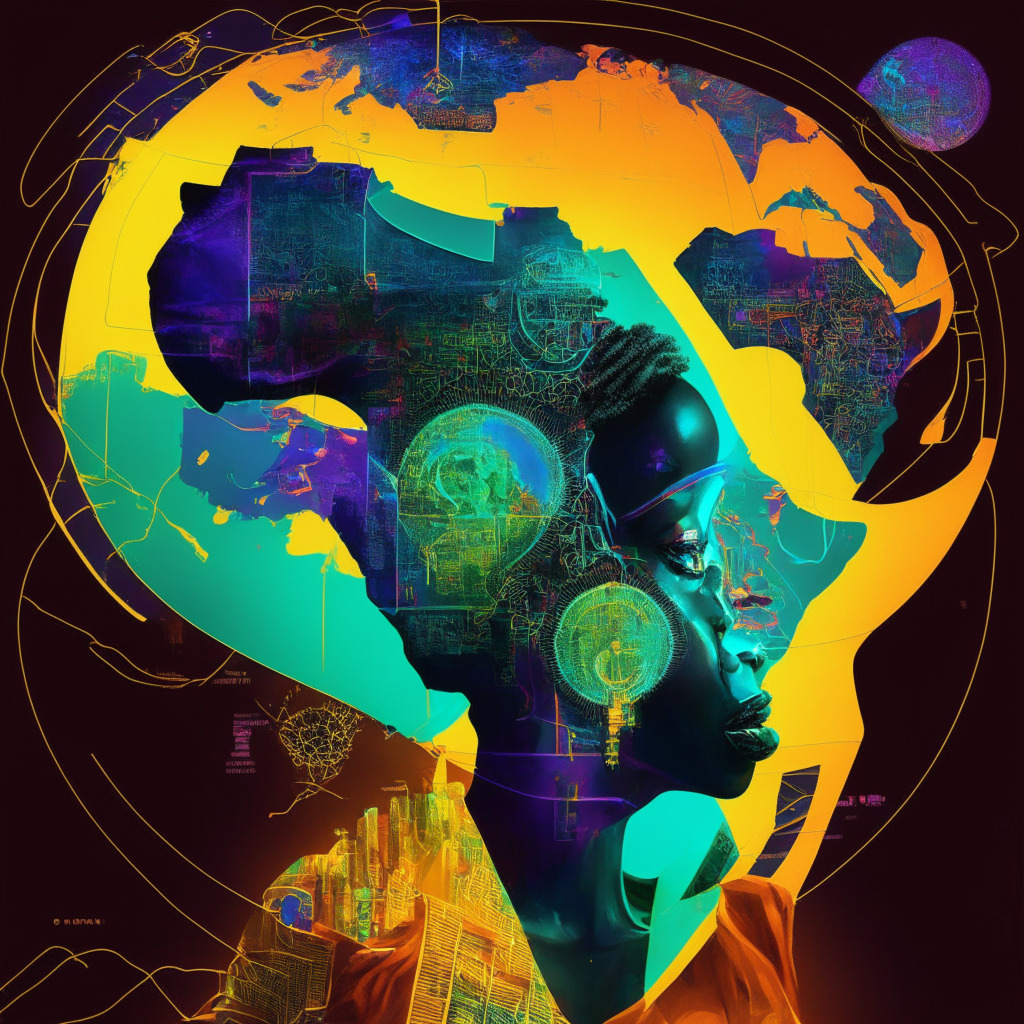Cisco Talos Intelligence Group found hackers use a Windows tool, Advanced Installer, to package malicious crypto-mining code with software installers of common design tools. Affected computers become carriers for malware miners, their powerful GPUs exploited to mine cryptocurrencies on behalf of the hackers, indicating increasing intersection between technological evolution and cybersecurity threats.
Search Results for: ASIC
Harnessing Blockchain’s Potential in Africa: The Intricate Tug-of-War with Poverty
“Blockchain technology’s mainstream adoption in Africa hinges on poverty eradication. Stakeholders believe a society devoid of poverty forms a stronger environment for blockchain incorporation. Despite economic struggles, Nigeria’s significant interest in cryptocurrencies and potential for blockchain integration shows promise. Nevertheless, this progress depends on achieving economic stability.”
Risk, Regulation and Innovation: The Saga of Crypto-Backed Loans in Australia
“Australian fintech Block Earner plans to introduce a new Bitcoin-secured loan service, despite possible regulatory issues. The product, expected by end-September, aligns with licensing structures and adheres to Australian credit license rules, according to the company’s co-founder and Head of Business.”
The Silent Threat: How CBDCs Could Erode Your Financial Freedom
“Central bank digital currencies (CBDCs) offer governments easy access to data collection, surveillance, and asset seizure. Although promoted for benefits such as tax collection and combating financial crime, these programmable money forms may lead to increased transaction censorship and misuse from state control. Counteracting this potential erosion of liberty, cryptocurrencies offer a means to safeguard transactional rights.”
Crypto Innovation Versus Regulation: The Hagerty-Gensler Faceoff
Sen. Bill Hagerty critiques SEC Chair Gary Gensler’s stance towards crypto, stating it stifles innovation and drives potential investors and companies overseas. He advocates for basic stablecoin regulations instead of comprehensive measures to improve the environment for U.S. crypto operations.
Shifting Alliances in Crypto Winter: MakerDAO’s Migration and Ethereum’s Controversy
“In the midst of a crypto winter, the blockchain industry is innovating and adapting. Major shifts like MakerDAO’s potential move from Ethereum to Solana or Cosmos depict this change. Discussions suggesting Ethereum should have a “Supreme Court” for disputes also indicate this evolution. Amid technological advances, the volatile crypto world is reminded: “Money doesn’t materialize out of thin air.””
The Ethereum Supreme Court: A Radical Notion to Enhance Blockchain Safety and Stability
Matter Labs CEO, Alex Gluchowski, suggests the creation of an “Ethereum Supreme Court” to mediate disputes that could impact the Ethereum blockchain’s integrity. His proposed system aims to formalize Ethereum’s “social consensus layer” to safeguard platforms against exploitation, enabling community-engaged contract-based mediation in crisis scenarios.
The Micro Revolution in Bitcoin Mining: Pocket-Sized Devices Against Industry Secrecy
Micro Bitcoin mining devices are small, cost-effective tools that aim to defy the secrecy and exclusivity associated with Bitcoin mining. Bitmaker’s devices, costing around $3, offer accessibility and transparency, fostering understanding and community participation in cryptocurrency despite limited profitability. These innovations symbolize a step towards democratization and decentralization in the crypto world.
Incredible Crypto-Awareness in Nigeria: An Unforeseen Leader in the Blockchain Revolution
In a recent survey by Consensys, 99% of Nigerians reportedly understand cryptocurrencies, making Nigeria the global leader in crypto-knowledge. Despite regulatory hurdles, 90% of respondents plan to invest in cryptocurrencies, viewing them as protection against hyperinflation. The survey underscores increasing global adoption of cryptocurrencies, particularly in economically troubled regions.
Navigating Crypto Regulations: Binance Australia’s Unfolding Narrative Amid Trials and Triumphs
“Binance Australia faces regulatory challenges and halted transactions due to high scam risks. Despite this, they remain committed to working with local authorities and resuscitating services for their customers. The Australian Treasury seeks to establish a token classification framework by 2024, marking a significant step towards a regulated crypto market.”
Empowering Africa with Cryptocurrencies: Challenges and Potentials
The crypto world, particularly Africa, faces challenges in widespread adoption due to lacking infrastructure and education. However, Christian Duffus, founder of Fonbnk, is optimistic for favorable crypto regulations and the development of local decentralized applications to promote unique solutions and possibilities.
Navigating The Storm: New Regulatory Frameworks on AI and Crypto Chip Exports Stir Global Markets
“Regulatory frameworks globally are revising their stance on ASIC chip exports, pivotal in cryptographic technologies. The U.S. Department of Commerce denies prohibiting AI chips sale to the Middle East. However, new regulations require tech giants to get licenses for selling flagship chips to some Middle Eastern countries.”
Australia’s Crypto Future: Binance’s Battle for Acceptance Amid Regulatory Tensions
“Cautious optimism pervades the Australian crypto community as Binance Australia General Manager Ben Rose voices confidence that regulators will create suitable guidelines for digital assets, despite recent regulatory tensions and banking blocks. Restoration of banking relationships and resuming fiat ramp service are top priorities.”
Navigating the Paradox of Worldcoin: Advancing Digital Identification vs Privacy Concerns
Worldcoin, a blockchain venture, recently enrolled over 9500 users in Argentina in one day. The project uses the users’ irises to verify their humanity, to combat AI programs mimicking human interaction. Despite criticisms concerning data privacy, sign-ups continue to surge worldwide. Interestingly, this project presents a paradox when examining technology, balancing digital identity verification against potential privacy compromises.
Web3 Gaming Breakthrough: Zynga’s Exciting Foray and Emerging Challenges
“Zynga, a mobile gaming giant, takes a leap into Web3 gaming with the introduction of ZW3 and Sugartown. However, as highlighted at Istanbul Blockchain Week 2023, there are concerns about the adoption and mechanics of Web3 games despite the promising prospects.”
Legal Fairness vs. Technological Demands: Insights from a Crypto CEO’s Confinement
The former FTX CEO, Sam Bankman-Fried, has found himself in legal troubles again. His defense team claims that limited internet access and subpar laptop technology at the detention center are impeding their preparation for the upcoming trial in October.
Navigating Cryptos: Dissecting Asset Handling Strategies from Hodling to Active Trading
“In the uncertain cryptocurrency landscape, experts suggest understanding basics before making bold decisions about investing or trading. Some suggest self-custody for asset control, while others trust institutions like Coinbase. Diversification, focusing on long-term over short-term fluctuations, and safety tools like stop losses are also recommended. Holding on to large-cap cryptocurrencies and using hardware wallets for secure long-term storage are considered safest.”
Bridging the Gap: ChatGPT as the Unlikely Hero in Web3 Development and Blockchain Adoption
“ChatGPT has emerged as a key tool in Web3 development, bridging knowledge gaps and simplifying learning about smart contract formations. It facilitates interaction with decentralized networks, assists in understanding the role of decentralized identities, and provides insights on future Web3 trends.”
Navigating Bitcoin Adoption in El Salvador: Promises, Pitfalls and Possibilities
Bitcoin holds promise in building an equitable financial system, but its understanding is a hurdle for many. In El Salvador, DitoBanx’s CEO aims to ease the transition, offering Bitcoin-based services to the unbanked. However challenges including volatility and apprehension towards crypto adoption persist.
Regulatory Tightrope in Crypto: Worldcoin’s Controversial Practices VS Digital Euro’s Promise
“The Worldcoin project, known for its retinal scans to differentiate humans from bots, is under scrutiny for potential violations of regulations, including data privacy and security threats. This situation highlights the necessity for balanced regulatory adherence as the crypto-space evolves, emphasizing consumer protection. On a separate note, the introduction of the digital euro could harmoniously coexist with private payment solutions, addressing cross-border payment issues and increasing accessibility.”
NFTs and the Creative Revolution: Tracing the Success of VR Artist Giant Swan amidst OpenSea’s Royalties Controversy
“In an era dominated by digital aesthetics, Non-Fungible Tokens (NFTs) have soared, offering artists unparalleled creative freedom. Particularly noteworthy is the Australian VR artist, Giant Swan, the first to put a 3D object on-chain. This innovation allows direct artist-collector sales, a leap forward from traditional social media trades. However, OpenSea’s choice to make creator royalties on secondary sales optional creates a significant challenge for creators striving for rightful compensation in an ever-evolving economy.”
Blockchain vs Traditional Payments: A Detailed Analysis of Utility, Constraints and Potential
Cross-border payments demonstrate the utility of digital currencies, yet adoption faces challenges like technological issues, competition, and regulatory constraints. Blockchain Officer, Paul Brody, suggests basic fiat payments are faster and cheaper through centralized systems, while blockchain payments can impact speed and cost due to duplication across nodes. Blockchain’s potential may not lie in replacing existing models, but in altering the transaction rules through tokenization and inherent programmability.
Wall Street Memes Coin: Disrupting the Crypto Realm Amid Market Downswing
“The Wall Street Memes coin has raised $25 million in its presale amid a downward crypto market. The project provides staking services with an annual yield of up to 283% and promises price stability. Endorsed by Elon Musk, it aims to empower retail investors against Wall Street leveraging the principles of decentralized empowerment. Wall Street Memes coin continues to attract investors with a $30 million hard cap target.”
Crypto Lender Faced with Penalty: The Cost of Misleading in Blockchain Industry
The Australian-based cryptocurrency lender, Helio Lending, was issued a non-conviction bond after falsely claiming to possess an Australian credit license. Australian Securities and Investments Commission (ASIC) alleges these false claims misled clients. This legal action emphasizes ASIC’s mission to regulate the volatile cryptocurrency space.
Unraveling Regulatory Compliance: Lessons from Helio Lending’s License Saga
“Australian crypto lender, Helio Lending, falsely claimed to hold an Australian Credit License, leading to a good behavior bond penalty by ASIC. This case highlights the need for blockchain companies to maintain credibility through regulatory compliance, elevates the role of regulatory bodies in licensing blockchain firms, and underscores the importance of honesty and ethical conduct in building community trust.”
Navigating AI in Online Search Engines and Cryptocurrency Mining: Potential & Peril
“Google’s recent upgrade to its search engine involves advanced generative AI features designed to enrich search results and quicken navigation in complex articles. In response, Quantum Blockchain Technologies is developing AI-powered algorithms to enhance Bitcoin mining efficiency. However, potential concerns include further consolidation of mining power, posing a risk to blockchain’s decentralization principle.”
Bitcoin’s Historic Journey: Europe’s First Spot ETF and its Global Implications
The Guernsey Financial Services Commission has approved the Jacobi FT Wilshere Bitcoin ETF, the first spot bitcoin exchange-traded fund in Europe. This highlights Europe’s progressive stance on integrating digital assets despite varying global regulations and the unstable nature of the crypto market. This development could serve as a model for similar funds globally.
Unraveling the Web of Deception Surrounding Crypto Mogul Bankman-Fried’s Legal Battle
“Sam Bankman-Fried, a renowned cryptocurrency figure, faces allegations of manipulating evidence and intimidating witnesses in a fraud case. Prosecutors suggest his untruthful narratives, attempts at tampering with witnesses, and use of VPN software to hide digital footprints could be misleading potential jurors and distorting the real story.”
Rethinking CBDC Adoption in a Well-Banked Nation: A Canadian Perspective
The Bank of Canada questions the adoption of Central Bank Digital Currencies (CBDCs) in a recent study, pointing to Canadians’ weak incentives for a switch given their well-established financial system. The discussion emphasizes on the continued importance of cash, especially for emergencies, listing out barriers for both users and merchants to broadly adopt a CBDC.
Unfurling the Future of Finances: Russia’s Digital Ruble Takes the First Leap
Russia is set to launch a pilot program for its digital ruble with 600 participants and 30 retailers. This Central Bank Digital Currency (CBDC) initiative follows China’s digital yuan strategy and could see the digital ruble in active use by 2025, transforming the country’s financial landscape. The token has potential for making and receiving cross-border payments.
Worldcoin: A New Era of Digital Identity or a Privacy Nightmare? Debating the Pros and Cons
Worldcoin, a novel blockchain technology, offers a unique digital ID through an iris scan, potentially opening up universal basic income opportunities. However, concerns about data privacy, verification issues, and the bleak market for AI tools pose significant challenges. While predicting its success is uncertain, its development signals a ripe opportunity with both risks and rewards.
Unveiling the Digital Ruble: Russia’s Leap into Blockchain Future and Its Implications
“The Bank of Russia advances its central bank digital currency (CBDC), unveiling the logo of its digital ruble. This indicates the undeniable influence of blockchain technology on financial systems. Still, challenges appear since CBDCs have the potential to disrupt traditional banking systems. The introduction of commission fees and slow mass adoption are some stumbling blocks.”































